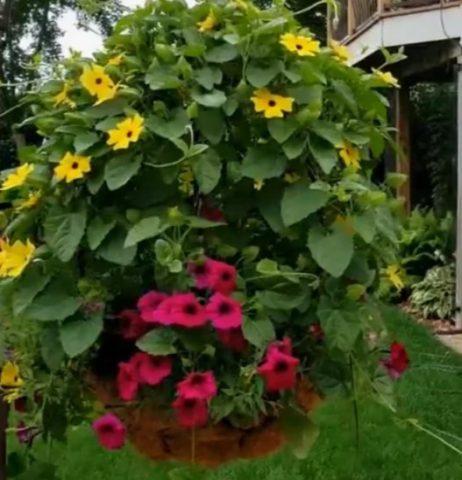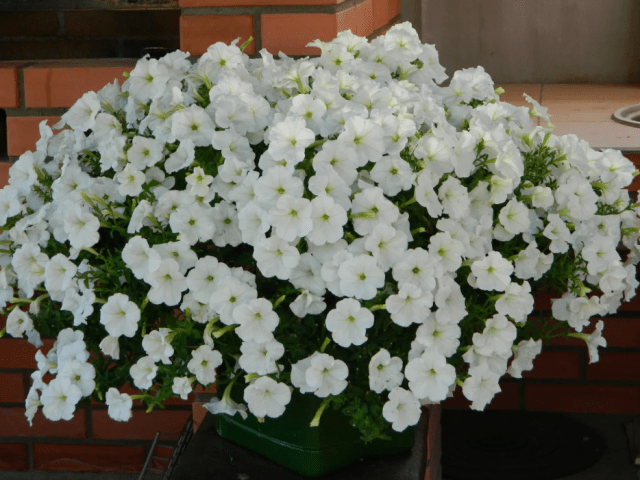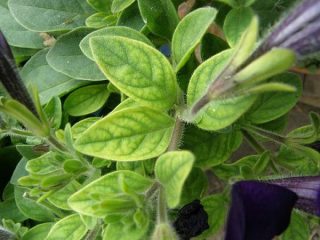Content
Petunias are distinguished by a very large variety of varieties. In particular, breeders have developed hanging hybrids that are ideal for vertical gardening. Planting petunias in flowerpots is a simple but effective solution: they are distinguished by their brightness, abundance and duration of flowering, and do not require complex care. Finding them “companions” for more complex “hanging” compositions is also not difficult.
The best varieties of ampelous petunias for hanging flowerpots
Petunia hybrids bred by breeders, including those suitable for flowerpots, are united in variety series under common names. From the photo it is obvious that in appearance they do not differ in anything, with the exception of the color of the petals.
Most often, the following types of petunias are chosen for hanging flowerpots:
- Shock Wave. The stems are 90-100 cm long. The flowers are medium-sized (4-5 cm in diameter). The palette includes white, scarlet, as well as blue-blue and pink-burgundy-purple tones.
Hybrid Shock Wave is extremely easy to care for and can withstand temperature changes without damage.
- Rosalie.Very lush bushes with relatively short (60-70 cm) stems. Flowering is long, the color of the petals is all kinds of shades of pink, from soft pastel to deep purple.
Petunia Rosalie is planted not only in flower pots, but also in flower beds - it turns into a fluffy “bump” with a diameter of about 1 m
- Opera. An ampelous hybrid with very long (110-120 cm) stems. The flowers are simple, with “waves” along the edges of the petals, about 6 cm in diameter. Colors are white, blue, red, pink-lilac-purple.
Despite the great length, the bases of the stems of the Opera hybrid do not “go bald”
- Diamond. Stems up to 80 cm long, intensively branching. The flowers are simple, large, about 9 cm in diameter. The palette is limited to white-red-pink shades.
Fungal diseases for the Diamond hybrid are extremely rare.
- Velvet. Often used as a ground cover plant. The stems stretch up to 90 cm. The color of the petals includes both pastel pink-peach tones and rich burgundy-violet.
The variety series Velvet gets its name from the velvety surface of the petals.
- Explorer. Stems are about 1 m long, densely leafy. The flowers are quite large (7-8 cm). The petals seem to be “waxy” and do not suffer from rain. “Basic” shades (white, scarlet, pink, blue-violet).
Hybrid Explorer blooms 7-10 days earlier than most hybrids
- Ultraviolet. The shoots stretch approximately 1 m. The flowers are large, simple, with “velvety” petals. The palette is limited to blue-violet shades.
Hybrids of the Ultraviolet series have a light sweetish aroma that intensifies in the heat
How to properly plant petunia in a flowerpot
Even with high-quality care, it will not be possible to achieve abundant and long-lasting flowering from a plant if its “requirements” for the quality of the substrate are not taken into account. The capacity itself also matters: it is selected according to certain criteria.
What kind of flowerpot is needed for petunia
Considering that the containers are located in the open air, the material from which they are made must maintain a presentable appearance under the influence of direct sunlight, heavy rain, and sharp gusts of wind. It is better to plant petunias in a hanging pot made of natural materials (clay, ceramics, wood) - they provide the roots with better aeration and prevent the soil from “acidifying.”
A mandatory requirement for containers is the presence of holes to drain excess water. You also need to pay attention to the edges - they should not be hard or sharp.

The stems of ampelous petunias are thin and fragile; in unsuitable pots they “grind” under their own weight
How many petunias should be planted in one pot?
If you plant several cascading or ampelous petunias in one pot, you need to take into account that each plant requires about 5 liters of soil. In most cases, the containers are hung, so a maximum of 3-5 petunias are placed in the pots. Otherwise, the entire structure turns out to be massive, and the risk of breaking the fastening system increases.
Soil for petunia in flower pots
In stores you can purchase a special substrate for petunias that suits the crop according to all criteria. It combines fairly high fertility with friability and a slightly acidic pH (5.5-5.8).
However, you can prepare the soil yourself.The soil mixture consists of fertile raised turf, ordinary garden turf, humus, peat chips and coarse sand, taken in a ratio of 2:2:2:2:1. Sand can be replaced with other “raising agents” (perlite, vermiculite, crushed sphagnum moss, coconut fiber).

As a rule, store-bought soil is “enriched” with fertilizers
Planting petunias in flowerpots
From the moment the seedlings emerge from the seeds until transplantation, 12-14 weeks pass. Accordingly, you need to sow petunia for planting in flowerpots quite early - from the last ten days of February to mid-March.
Petunias are planted in pots using the transshipment method. The only exception is seedlings grown in peat tablets or pots. This petunia can be planted in a flower pot directly with the container.
The procedure follows a standard algorithm:
- About an hour in advance, water the seedlings well to make it easier to remove them from the containers.
- Place a 3-4 cm thick layer of any drainage material on the bottom of the container. On top of it, fill the container approximately 2/3 with substrate. Water it moderately and let the water absorb.
- Remove the seedlings from the cup, maintaining the integrity of the soil ball on the roots if possible, and transfer the plant to a container. Add soil, compact it slightly, and water the plant moderately again.

Often, by the time of transplantation, buds and even open flowers appear on the plants - this is not an obstacle
Caring for petunia in flower pots
Even novice flower growers can grow ampelous petunias in flower pots. However, one must take into account the “confined space” to which the plant is limited to obtain water and nutrients.
Watering
If plants are watered too often and/or abundantly, root rot, which is “killer” for them, quickly develops. Specimens in containers with overdried soil look unpresentable, but with normal watering they can quickly restore their decorative appearance and begin to form buds.
There is no clear watering schedule. It is necessary to take into account air temperature, frequency and intensity of precipitation. In extreme heat, plants are watered twice a day - in the morning and in the evening. If it’s warm enough and sunny outside - every day or every two days. In cool, cloudy weather, it is enough to moisten the soil every 3-5 days.

Petunia cannot be called a drought-resistant plant, but it tolerates waterlogged soil even worse
Top dressing
Considering the limited volume of soil, as well as the abundance and duration of flowering of the crop, it is easy to understand that it is impossible to grow beautiful petunia in a hanging pot without regular fertilizing. Fertilizers are applied at intervals of 15-20 days, starting with “mass” budding and until approximately mid-autumn.
In principle, natural organics and folk remedies are also suitable for petunias. However, for plants in pots, it is advisable to use specialized store-bought preparations for flowering annuals.They are distinguished by a balanced composition, containing not only “basic” macroelements, but also a complex of microelements.

Natural fertilizers can cause a persistent unpleasant odor from flower pots and attract “undesirable” insects to the balcony or veranda
Wintering
Petunia in flowerpots at the dacha in Russia is grown exclusively as an annual. But, in principle, the plant is able to remain decorative for 3-4 seasons. To “extend the life” of specimens in pots, they are brought into a bright room, ensuring a constant temperature of 12-15 °C. Plants are watered infrequently (once every 10-15 days), and fertilizing is not carried out.
How to shape petunia for a hanging planter
In addition to sanitary pruning (timely removal of wilted buds and dried stems), plants need shaping. Most varieties of petunias intended for hanging planters take on a ball-like shape with minimal “help” from the gardener.
For greater bushiness, the main stem and emerging side shoots are pinched after the 5-6th leaf. Then the procedure is repeated approximately once a month, making sure that the remaining part of the stem is no shorter than 12-15 cm.

Pinching slightly shifts the beginning of flowering, but in the future many more buds are formed on the petunia than without it.
Some hybrids of ampelous petunias already stretch out unsightly by mid-summer. To restore their decorative properties, all shoots are cut short, shortening them by at least a third (preferably even by half).
Compositions with petunia in flowerpots
Due to the variety of petal colors and flower shapes, petunia can be planted “solo” in flowerpots. However, it’s also not difficult to find “companions” for her to create spectacular compositions. Photos of petunias in pots around the house taken by gardeners confirm this.

An original “wall” of pots “hidden” in drawers, in which petunias are planted in combination with silver-colored euphorbia and dichondra

The combination of petunia and lobelia can be called a “classic of the genre”

A composition of bright multi-colored petunias in flowerpots does not seem tiring to the eyes

Not the most obvious, but very harmonious combination of soft lilac petunias and inky purple calibrachoa with peach snapdragons

Stylish, bright and catchy composition of crimson-pink ampelous petunias, complemented by nephrolepsis

The shape of the ball of ampelous petunia in a flowerpot is repeated by bacopa and morning glory; gypsophila and ageratum also “work” to create the overall impression of “lushness.”

Without the burgundy ampelous petunia, this whole structure in a flowerpot, braided with thunbergia, would seem boring
Conclusion
Since there are many hanging hybrids, planting petunias in pots is an option for growing them, which is popular with both amateur gardeners and professional landscape designers. They look impressive both “solo” and as part of compositions with other flowering or decorative foliage plants.















